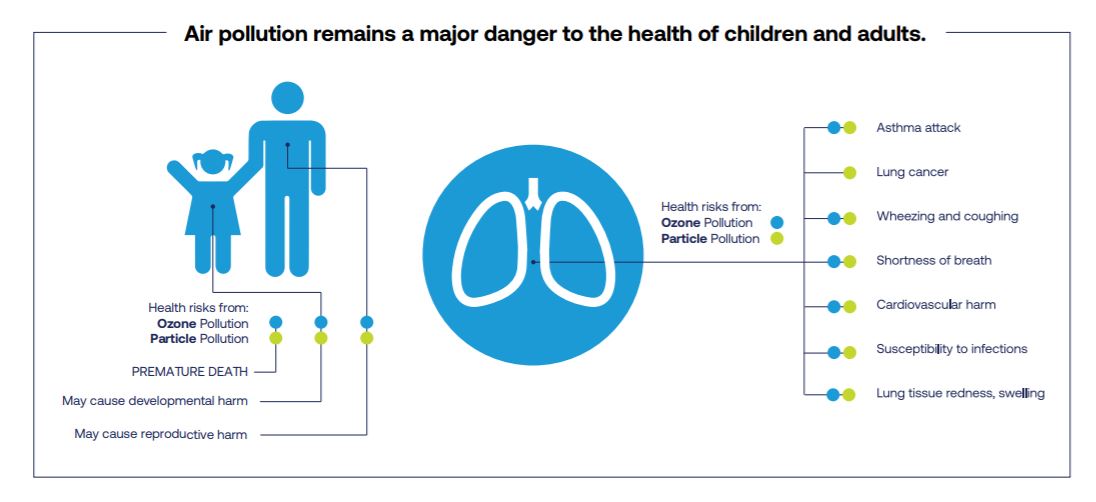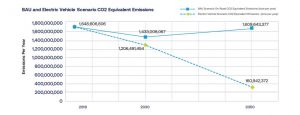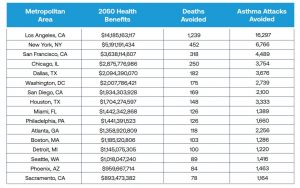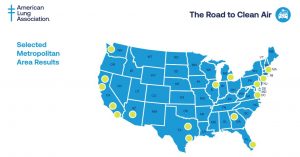

Energy
EVs like Teslas will save lives and billions in health costs in 2050: ALA report
The American Lung Association recently published a report advocating for a nationwide transition to electric vehicle (EV) transportation. Specifically highlighting public health, air quality, and climate change benefits that will be brought about by the widespread use of electric cars, the organization estimates over 6,000 saved lives, $70 billion dollars in health cost savings, and $113 billion dollars in climate-driven savings in 2050 if zero emissions from vehicles are achieved by that year.
“The widespread transition to zero-emission transportation technologies could produce emission reductions in 2050 that could add up to $72 billion in avoided health harms, saving approximately 6,300 lives and avoiding more than 93,000 asthma attacks and 416,000 lost workdays annually due to significant reductions in transportation-related pollution avoiding more than 93,000 asthma attacks and 416,000 lost workdays annually due to significant reductions in transportation-related pollution,” the report summarizes.
“[T]he benefits to our environment in the form of avoided climate change impacts, as expressed as the Social Cost of Carbon, could surpass $113 billion in 2050 as the transportation systems combust far less fuel and our power system comes to rely on cleaner, non-combustion renewable energy. This value reflects a range of negative consequences to health, agricultural productivity, flood risk and other adverse impacts generated by carbon emissions in the form of global climate change.”


In “The Road to Clean Air,” the American Lung Association (ALA) provides a number of comparisons of reduced emissions against the current environment, i.e., Business as Usual. All states in the US were shown to benefit significantly in terms of health and economic productivity, but specific metro areas were highlighted given traffic congestion and pedestrian proximity to vehicle emissions. “Eighteen states show annual benefits reaching $1 billion or more in 2050 while even the smallest states see benefits in the tens to hundreds of millions,” the report detailed.
“The transition to zero-emission transportation will benefit the health of children riding school buses, daily commuters and transit riders, truckers and local delivery drivers and especially those residents nearest major roadways, warehouse distribution centers and other pollution hotspots,” the report added.
- (Image: The American Lung Association)
- (Image: The American Lung Association)
- (Image: The American Lung Association)
- (Image: The American Lung Association)
Along with detailing the benefits of a zero-emissions transportation sector in the US, the ALA also proposed a few action recommendations in their report. Key among them were establishing policies at the federal and local levels which prioritize zero-emission transportation (extending incentive programs, increasing grant funding for bus/truck purchases) and investing in infrastructure changes that provide for charging networks in all areas where they’d be necessary for widespread adoption (parking garages, workplaces, multi-unit housing). On an individual level, the ALA recommended changing energy providers to those with clean-energy sources and test driving (ultimately buying if in the market) electric cars to familiarize oneself with their features and benefits.
The long-term societal benefits that EVs like Teslas may offer are well-known by their most enthusiastic proponents, and this recent ALA report is yet another confirmation of the data that drives their advocacy. Tesla CEO Elon Musk, with both his fans and fans of the company’s vehicles following suit, are counted as some of the most vocal and action-oriented about these potentials. Since Musk’s first Master Plan was published in 2006, Tesla has been pushing to achieve the zero-emissions transportation future laid out by the American Lung Association’s recent report. The Boring Company’s tunneling with all-electric vehicles providing the passenger ferrying will also play a part in this plan, even if not originally included. Finally, with Tesla’s renewed focus on expanding the solar energy side of the business, Musk and company hope to tackle the climate change impacts on both US and international health as well.
Read the ALA’s electric vehicle report below.
ALA – Electric Vehicle Report by Simon Alvarez on Scribd

Cybertruck
Tesla updates Cybertruck owners about key Powershare feature

Tesla is updating Cybertruck owners on its timeline of a massive feature that has yet to ship: Powershare with Powerwall.
Powershare is a bidirectional charging feature exclusive to Cybertruck, which allows the vehicle’s battery to act as a portable power source for homes, appliances, tools, other EVs, and more. It was announced in late 2023 as part of Tesla’s push into vehicle-to-everything energy sharing, and acting as a giant portable charger is the main advantage, as it can provide backup power during outages.
Cybertruck’s Powershare system supports both vehicle-to-load (V2L) and vehicle-to-home (V2H), making it flexible and well-rounded for a variety of applications.
However, even though the feature was promised with Cybertruck, it has yet to be shipped to vehicles. Tesla communicated with owners through email recently regarding Powershare with Powerwall, which essentially has the pickup act as an extended battery.
Powerwall discharge would be prioritized before tapping into the truck’s larger pack.
However, Tesla is still working on getting the feature out to owners, an email said:
“We’re writing to let you know that the Powershare with Powerwall feature is still in development and is now scheduled for release in mid-2026.
This new release date gives us additional time to design and test this feature, ensuring its ability to communicate and optimize energy sharing between your vehicle and many configurations and generations of Powerwall. We are also using this time to develop additional Powershare features that will help us continue to accelerate the world’s transition to sustainable energy.”
Owners have expressed some real disappointment in Tesla’s continuous delays in releasing the feature, as it was expected to be released by late 2024, but now has been pushed back several times to mid-2026, according to the email.
Foundation Series Cybertruck buyers paid extra, expecting the feature to be rolled out with their vehicle upon pickup.
Cybertruck’s Lead Engineer, Wes Morrill, even commented on the holdup:
As a Cybertruck owner who also has Powerwall, I empathize with the disappointed comments.
To their credit, the team has delivered powershare functionality to Cybertruck customers who otherwise have no backup with development of the powershare gateway. As well as those with solar…
— Wes (@wmorrill3) December 12, 2025
He said that “it turned out to be much harder than anticipated to make powershare work seamlessly with existing Powerwalls through existing wall connectors. Two grid-forming devices need to negotiate who will form and who will follow, depending on the state of charge of each, and they need to do this without a network and through multiple generations of hardware, and test and validate this process through rigorous certifications to ensure grid safety.”
It’s nice to see the transparency, but it is justified for some Cybertruck owners to feel like they’ve been bait-and-switched.
Energy
Tesla starts hiring efforts for Texas Megafactory
Tesla’s Brookshire site is expected to produce 10,000 Megapacks annually, equal to 40 gigawatt hours of energy storage.

Tesla has officially begun hiring for its new $200 million Megafactory in Brookshire, Texas, a manufacturing hub expected to employ 1,500 people by 2028. The facility, which will build Tesla’s grid-scale Megapack batteries, is part of the company’s growing energy storage footprint.
Tesla’s hiring efforts for the Texas Megafactory are hinted at by the job openings currently active on the company’s Careers website.
Tesla’s Texas Megafactory
Tesla’s Brookshire site is expected to produce 10,000 Megapacks annually, equal to 40 gigawatt hours of energy storage, similar to the Lathrop Megafactory in California. Tesla’s Careers website currently lists over 30 job openings for the site, from engineers, welders, and project managers. Each of the openings is listed for Brookshire, Texas.
The company has leased two buildings in Empire West Business Park, with over $194 million in combined property and equipment investment. Tesla’s agreement with Waller County includes a 60% property tax abatement, contingent on meeting employment benchmarks: 375 jobs by 2026, 750 by 2027, and 1,500 by 2028, as noted in a report from the Houston Business Journal. Tesla is required to employ at least 1,500 workers in the facility through the rest of the 10-year abatement period.
Tesla’s clean energy boom
City officials have stated that Tesla’s arrival marks a turning point for the Texas city, as it highlights a shift from logistics to advanced clean energy manufacturing. Ramiro Bautista from Brookshire’s economic development office, highlighted this in a comment to the Journal.
“(Tesla) has great-paying jobs. Not just that, but the advanced manufacturing (and) clean energy is coming to the area,” he said. “So it’s not just your normal logistics manufacturing. This is advanced manufacturing coming to this area, and this brings a different type of job and investment into the local economy.”
Energy
Tesla and Samsung SDI in talks over new US battery storage deal: report
The update was related by industry sources and initially reported by South Korean news outlets.

Recent reports have suggested that Tesla and Samsung SDI are in talks over a potential partnership to supply batteries for large-scale energy storage systems (ESS).
The update was related by industry sources and initially reported by South Korean news outlets.
ESS batteries to be built at Samsung’s Indiana plant
As noted in a report from Korea JoongAng Daily, the demand for energy storage systems has been growing rapidly in North America, thanks in no small part to the surge in AI investments across numerous companies. With this in mind, Tesla has reportedly approached Samsung SDI about a potential battery supply deal.
The deal is reportedly worth over 3 trillion Korean won (approximately $2.11 billion) and will span three years, according to The Korea Global Economic Daily. A battery supply deal with Samsung SDI could make sense for Tesla as the company already has a grid-scale battery, the Megapack, which is perfect for industrial use. Samsung SDI could simply supply cells for the EV maker.
Production of the batteries would reportedly take place at Samsung SDI’s joint venture factory with Stellantis in Indiana, which is currently under construction. Samsung SDI recently announced plans to use part of that plant’s EV lines to produce cells for ESS, with a targeted capacity of 30 GWh by the end of next year.
Tesla and Samsung’s partnership
At present, only a handful of manufacturers, including Korea’s LG Energy Solution, Samsung SDI, SK On, and Japan’s Panasonic, are capable of producing energy storage-scale batteries domestically in the United States. A Samsung SDI official issued a comment about the matter, stating, “Nothing has been finalized regarding cooperation with Tesla.”
The possible energy storage system deal adds another layer to Tesla’s growing collaboration with Samsung, which is already in line as a partner in the upcoming production of Tesla’s AI5 and AI6 chips. Early sample manufacturing of the AI6 is expected to begin in South Korea, with mass production slated for Samsung’s Texas-based Taylor foundry when it starts operations.
The AI6 chip will power Tesla’s next wave of high-volume projects, including the Optimus humanoid robot and the autonomous Cybercab service. Musk has called the partnership with Samsung a “real collaboration,” adding that he personally plans to “walk the line” at the Taylor facility to speed up progress.












